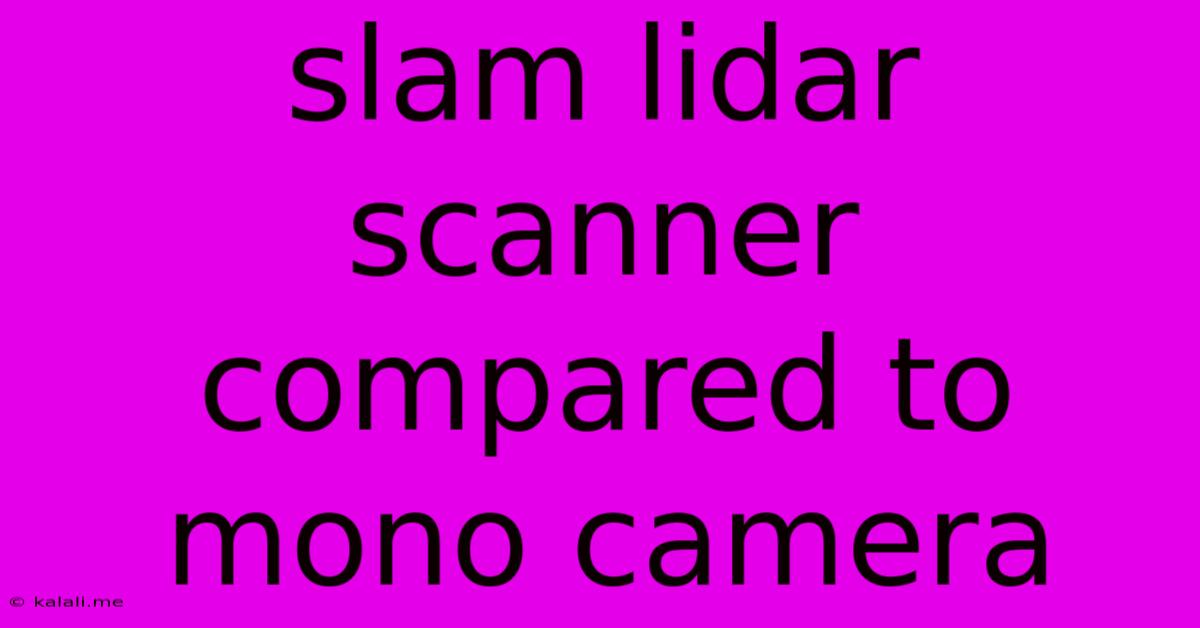Slam Lidar Scanner Compared To Mono Camera
Kalali
Jun 05, 2025 · 3 min read

Table of Contents
SLAM LiDAR Scanner vs. Mono Camera: A Comprehensive Comparison for Autonomous Navigation
This article dives deep into the comparison between SLAM (Simultaneous Localization and Mapping) using LiDAR scanners and mono cameras, exploring their strengths, weaknesses, and ideal applications in autonomous navigation and robotics. Understanding these differences is crucial for selecting the optimal sensor technology for your specific project.
What is SLAM? Simultaneous Localization and Mapping is a process where a robot or autonomous vehicle builds a map of an unknown environment while simultaneously keeping track of its location within that map. Both LiDAR and mono cameras can be used for SLAM, but they achieve this in fundamentally different ways.
LiDAR-based SLAM: The Power of 3D Point Clouds
LiDAR (Light Detection and Ranging) scanners use lasers to measure distances to objects, creating a detailed 3D point cloud representation of the environment. This provides highly accurate depth information, crucial for precise localization and map building.
Strengths of LiDAR SLAM:
- High Accuracy and Precision: LiDAR offers superior accuracy in measuring distances and creating detailed 3D maps, especially in challenging lighting conditions.
- Robustness to Lighting Changes: Unlike cameras, LiDAR performance is not significantly affected by varying lighting levels, making it suitable for both indoor and outdoor environments.
- Direct Depth Measurement: LiDAR directly measures depth, eliminating the need for complex computational processes to infer depth from images, as required by cameras.
- Easy Obstacle Detection: The 3D point cloud readily reveals obstacles, simplifying navigation and collision avoidance.
Weaknesses of LiDAR SLAM:
- Cost: LiDAR sensors, particularly high-resolution ones, can be significantly more expensive than cameras.
- Size and Weight: LiDAR units can be bulky and heavy, limiting their applicability in certain applications.
- Sensitivity to Reflections and Occlusions: Highly reflective surfaces or dense foliage can interfere with LiDAR's ability to accurately measure distances.
Mono Camera-based SLAM: The Vision-based Approach
Mono camera SLAM utilizes a single camera to estimate depth and build a map of the surroundings. This relies heavily on computer vision algorithms to process images and infer 3D information.
Strengths of Mono Camera SLAM:
- Low Cost: Cameras are significantly cheaper than LiDAR sensors.
- Small Size and Weight: Cameras are compact and lightweight, making them ideal for integration into smaller robots and drones.
- Rich Feature Information: Images provide rich visual information that can be used for object recognition and scene understanding, beyond just localization and mapping.
Weaknesses of Mono Camera SLAM:
- Lower Accuracy: Depth estimation from a single image is inherently less accurate than direct depth measurement from LiDAR.
- Sensitivity to Lighting Conditions: Performance can be drastically affected by changes in lighting, shadows, and low-light conditions.
- Computational Complexity: Processing images and inferring 3D information requires significant computational power.
- Scale Ambiguity: A mono camera cannot directly determine the scale of the environment; additional information or constraints are needed.
Choosing the Right Sensor: LiDAR or Mono Camera?
The optimal choice between LiDAR and mono camera SLAM depends on the specific application requirements:
- High-precision autonomous driving: LiDAR is generally preferred for its accuracy and robustness.
- Low-cost robotics applications: Mono cameras offer a cost-effective solution, especially for applications where precise depth information is less critical.
- Applications requiring object recognition: Mono cameras, with their rich visual information, are better suited for this task.
- Indoor navigation in well-lit environments: Both LiDAR and mono cameras can be effective.
- Outdoor navigation in various lighting conditions: LiDAR is more reliable due to its robustness to lighting changes.
Conclusion:
Both LiDAR and mono camera-based SLAM systems offer unique advantages and disadvantages. The best choice depends on the specific needs of the application, balancing factors like accuracy, cost, size, computational requirements, and environmental conditions. In some advanced systems, a sensor fusion approach, combining both LiDAR and cameras, may offer the optimal solution for achieving highly reliable and robust autonomous navigation.
Latest Posts
Latest Posts
-
How Tall Should Dining Room Table Legs Be
Jun 07, 2025
-
How Often Should A Sump Pump Run
Jun 07, 2025
-
How To Clean Mold Off Cement
Jun 07, 2025
-
Can I Use A Community Email List For Personal Reasons
Jun 07, 2025
-
How To Find Out Why Ffmpeg In Memory Is Large
Jun 07, 2025
Related Post
Thank you for visiting our website which covers about Slam Lidar Scanner Compared To Mono Camera . We hope the information provided has been useful to you. Feel free to contact us if you have any questions or need further assistance. See you next time and don't miss to bookmark.